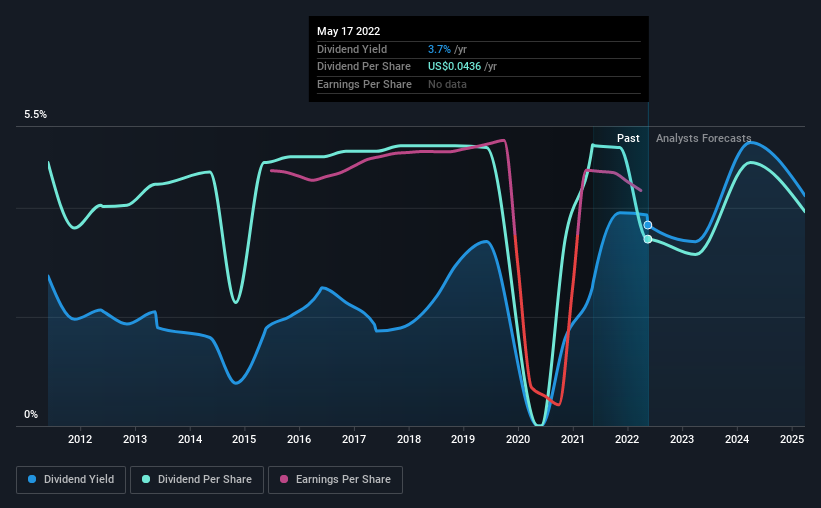- Hong Kong
- /
- Auto Components
- /
- SEHK:179
Johnson Electric Holdings' (HKG:179) Dividend Is Being Reduced To HK$0.17

Johnson Electric Holdings Limited (HKG:179) has announced it will be reducing its dividend payable on the 7th of September to HK$0.17. This means that the annual payment will be 3.7% of the current stock price, which is in line with the average for the industry.
While the dividend yield is important for income investors, it is also important to consider any large share price moves, as this will generally outweigh any gains from distributions. Johnson Electric Holdings' stock price has reduced by 32% in the last 3 months, which is not ideal for investors and can explain a sharp increase in the dividend yield.
Check out our latest analysis for Johnson Electric Holdings
Johnson Electric Holdings Doesn't Earn Enough To Cover Its Payments
We like to see a healthy dividend yield, but that is only helpful to us if the payment can continue. Prior to this announcement, Johnson Electric Holdings' earnings easily covered the dividend, but free cash flows were negative. In general, we consider cash flow to be more important than earnings, so we would be cautious about relying on the sustainability of this dividend.
Over the next year, EPS is forecast to fall by 2.3%. Assuming the dividend continues along recent trends, we believe the payout ratio could reach over 200%, which could put the dividend under pressure if earnings don't start to improve.

Dividend Volatility
While the company has been paying a dividend for a long time, it has cut the dividend at least once in the last 10 years. The first annual payment during the last 10 years was US$0.061 in 2012, and the most recent fiscal year payment was US$0.044. Doing the maths, this is a decline of about 3.4% per year. A company that decreases its dividend over time generally isn't what we are looking for.
Dividend Growth Potential Is Shaky
Given that the dividend has been cut in the past, we need to check if earnings are growing and if that might lead to stronger dividends in the future. Johnson Electric Holdings' EPS has fallen by approximately 10% per year during the past five years. Such rapid declines definitely have the potential to constrain dividend payments if the trend continues into the future.
Johnson Electric Holdings' Dividend Doesn't Look Sustainable
Overall, it's not great to see that the dividend has been cut, but this might be explained by the payments being a bit high previously. While Johnson Electric Holdings is earning enough to cover the payments, the cash flows are lacking. We would probably look elsewhere for an income investment.
Investors generally tend to favour companies with a consistent, stable dividend policy as opposed to those operating an irregular one. However, there are other things to consider for investors when analysing stock performance. As an example, we've identified 4 warning signs for Johnson Electric Holdings that you should be aware of before investing. Is Johnson Electric Holdings not quite the opportunity you were looking for? Why not check out our selection of top dividend stocks.
If you're looking to trade Johnson Electric Holdings, open an account with the lowest-cost platform trusted by professionals, Interactive Brokers.
With clients in over 200 countries and territories, and access to 160 markets, IBKR lets you trade stocks, options, futures, forex, bonds and funds from a single integrated account.
Enjoy no hidden fees, no account minimums, and FX conversion rates as low as 0.03%, far better than what most brokers offer.
Sponsored ContentNew: Manage All Your Stock Portfolios in One Place
We've created the ultimate portfolio companion for stock investors, and it's free.
• Connect an unlimited number of Portfolios and see your total in one currency
• Be alerted to new Warning Signs or Risks via email or mobile
• Track the Fair Value of your stocks
Have feedback on this article? Concerned about the content? Get in touch with us directly. Alternatively, email editorial-team (at) simplywallst.com.
This article by Simply Wall St is general in nature. We provide commentary based on historical data and analyst forecasts only using an unbiased methodology and our articles are not intended to be financial advice. It does not constitute a recommendation to buy or sell any stock, and does not take account of your objectives, or your financial situation. We aim to bring you long-term focused analysis driven by fundamental data. Note that our analysis may not factor in the latest price-sensitive company announcements or qualitative material. Simply Wall St has no position in any stocks mentioned.
About SEHK:179
Johnson Electric Holdings
An investment holding company, engages in the manufacture and sale of motion systems worldwide.
Flawless balance sheet, good value and pays a dividend.
Similar Companies
Market Insights
Community Narratives



